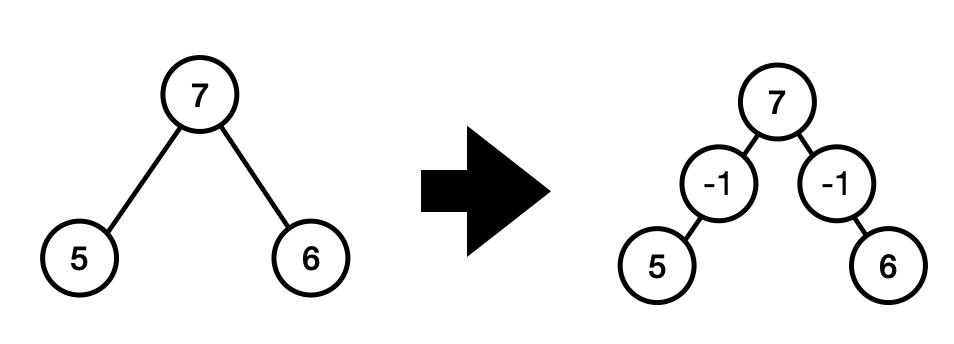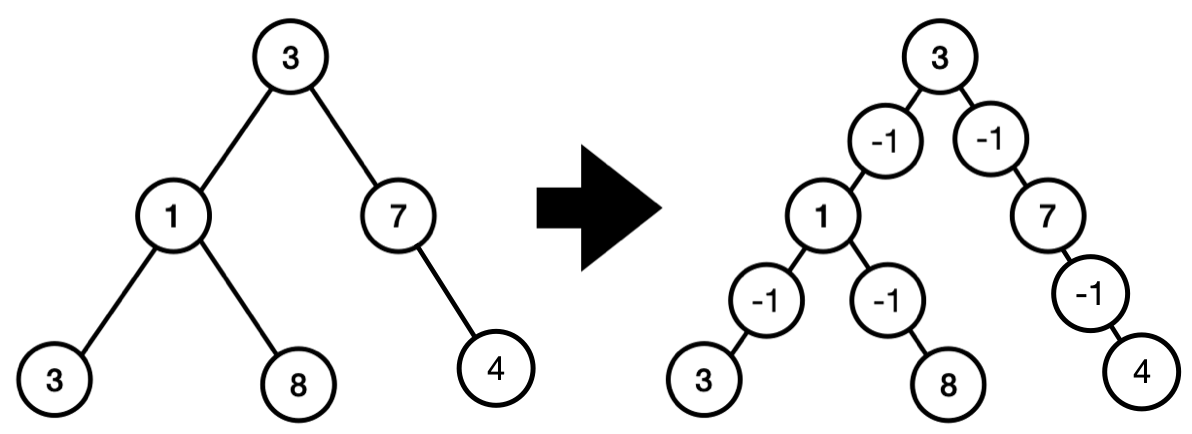力扣嘉年华上的 DIY 手工展位准备了一棵缩小版的 二叉 装饰树 root 和灯饰,你需要将灯饰逐一插入装饰树中,要求如下:
- 完成装饰的二叉树根结点与
root的根结点值相同 - 若一个节点拥有父节点,则在该节点和他的父节点之间插入一个灯饰(即插入一个值为
-1的节点)。具体地:- 在一个 父节点 x 与其左子节点 y 之间添加 -1 节点, 节点 -1、节点 y 为各自父节点的左子节点,
- 在一个 父节点 x 与其右子节点 y 之间添加 -1 节点, 节点 -1、节点 y 为各自父节点的右子节点,
现给定二叉树的根节点 root ,请返回完成装饰后的树的根节点。
示例 1:
输入:
root = [7,5,6]输出:
[7,-1,-1,5,null,null,6]
示例 2:
输入:
root = [3,1,7,3,8,null,4]输出:
[3,-1,-1,1,null,null,7,-1,-1,null,-1,3,null,null,8,null,4]
提示:
0 <= root.Val <= 1000>root节点数量范围为[1, 10^5]
方法一:递归
我们设计一个函数
函数
- 若
为空,则返回空; - 否则,递归地对
的左右子树分别调用 函数,得到插入灯饰后的左右子树的根节点 和 ; - 若
不为空,则我们创建一个新节点 ,并将其作为 的左子节点; - 若
不为空,则我们创建一个新节点 ,并将其作为 的右子节点;
最后,返回
时间复杂度
# Definition for a binary tree node.
# class TreeNode:
# def __init__(self, val=0, left=None, right=None):
# self.val = val
# self.left = left
# self.right = right
class Solution:
def expandBinaryTree(self, root: Optional[TreeNode]) -> Optional[TreeNode]:
def dfs(root):
if root is None:
return None
l, r = dfs(root.left), dfs(root.right)
if l:
root.left = TreeNode(-1, l)
if r:
root.right = TreeNode(-1, None, r)
return root
return dfs(root)/**
* Definition for a binary tree node.
* public class TreeNode {
* int val;
* TreeNode left;
* TreeNode right;
* TreeNode() {}
* TreeNode(int val) { this.val = val; }
* TreeNode(int val, TreeNode left, TreeNode right) {
* this.val = val;
* this.left = left;
* this.right = right;
* }
* }
*/
class Solution {
public TreeNode expandBinaryTree(TreeNode root) {
return dfs(root);
}
private TreeNode dfs(TreeNode root) {
if (root == null) {
return null;
}
TreeNode l = dfs(root.left);
TreeNode r = dfs(root.right);
if (l != null) {
root.left = new TreeNode(-1, l, null);
}
if (r != null) {
root.right = new TreeNode(-1, null, r);
}
return root;
}
}/**
* Definition for a binary tree node.
* struct TreeNode {
* int val;
* TreeNode *left;
* TreeNode *right;
* TreeNode() : val(0), left(nullptr), right(nullptr) {}
* TreeNode(int x) : val(x), left(nullptr), right(nullptr) {}
* TreeNode(int x, TreeNode *left, TreeNode *right) : val(x), left(left), right(right) {}
* };
*/
class Solution {
public:
TreeNode* expandBinaryTree(TreeNode* root) {
function<TreeNode*(TreeNode*)> dfs = [&](TreeNode* root) -> TreeNode* {
if (!root) {
return nullptr;
}
TreeNode* l = dfs(root->left);
TreeNode* r = dfs(root->right);
if (l) {
root->left = new TreeNode(-1, l, nullptr);
}
if (r) {
root->right = new TreeNode(-1, nullptr, r);
}
return root;
};
return dfs(root);
}
};/**
* Definition for a binary tree node.
* type TreeNode struct {
* Val int
* Left *TreeNode
* Right *TreeNode
* }
*/
func expandBinaryTree(root *TreeNode) *TreeNode {
var dfs func(*TreeNode) *TreeNode
dfs = func(root *TreeNode) *TreeNode {
if root == nil {
return root
}
l, r := dfs(root.Left), dfs(root.Right)
if l != nil {
root.Left = &TreeNode{-1, l, nil}
}
if r != nil {
root.Right = &TreeNode{-1, nil, r}
}
return root
}
return dfs(root)
}

